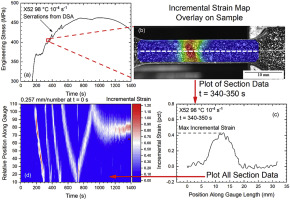当前位置:
X-MOL 学术
›
Int. J. Plasticity
›
论文详情
Our official English website, www.x-mol.net, welcomes your feedback! (Note: you will need to create a separate account there.)
Characterization of localized plastic deformation behaviors associated with dynamic strain aging in pipeline steels using digital image correlation
International Journal of Plasticity ( IF 9.8 ) Pub Date : 2019-12-01 , DOI: 10.1016/j.ijplas.2019.07.010 Taylor R. Jacobs , David K. Matlock , Kip O. Findley
International Journal of Plasticity ( IF 9.8 ) Pub Date : 2019-12-01 , DOI: 10.1016/j.ijplas.2019.07.010 Taylor R. Jacobs , David K. Matlock , Kip O. Findley

|
Abstract Localized deformation behavior in X52 and X70 pipeline steels during dynamic strain aging (or DSA, caused by interstitial atom-dislocation interactions during plastic deformation) were systematically assessed using digital image correlation with incremental strain analysis during elevated temperature tensile testing in the range of 25–350 °C. Similar to materials that use substitutional atoms for DSA, deformation band propagation and nucleation behaviors in the steels were directly related to the morphologies of flow curves from the tensile data. Comparisons between the steels and substitutional DSA systems were made. The type of localized deformation behavior was dependent on the temperature and strain rate conditions of the tensile test and the total amount of strain in the sample. Plastic flow was primarily dominated by deformation band propagation and nucleation at relatively low and high temperatures respectively within the DSA regime. It was theorized that the changing serration morphologies and deformation behaviors at different temperature-strain rate conditions were due to relative differences between the mobility of the solute atoms and the velocity of the mobile dislocations throughout the DSA regime. The dislocation density (which increases due to strain hardening during a tensile test) also influenced deformation behavior at relatively low and high strains.
中文翻译:

使用数字图像相关性表征与管线钢动态应变时效相关的局部塑性变形行为
摘要 在 25 ℃ 的高温拉伸试验期间,使用数字图像相关性和增量应变分析系统地评估了 X52 和 X70 管线钢在动态应变时效(或 DSA,由塑性变形期间的间隙原子-位错相互作用引起)期间的局部变形行为。 –350°C。与使用置换原子进行 DSA 的材料类似,钢中的变形带传播和成核行为与拉伸数据中流动曲线的形态直接相关。对钢和替代 DSA 系统进行了比较。局部变形行为的类型取决于拉伸试验的温度和应变速率条件以及样品中的总应变量。塑性流动主要由分别在 DSA 范围内的相对低温和高温下的变形带传播和成核主导。理论上,不同温度-应变速率条件下不断变化的锯齿形貌和变形行为是由于溶质原子的迁移率和整个 DSA 机制中的移动位错速度之间的相对差异。位错密度(由于拉伸试验期间的应变硬化而增加)也会影响相对低应变和高应变下的变形行为。理论上,不同温度-应变速率条件下不断变化的锯齿形貌和变形行为是由于溶质原子的迁移率和整个 DSA 机制中的移动位错速度之间的相对差异。位错密度(由于拉伸试验期间的应变硬化而增加)也会影响相对低应变和高应变下的变形行为。理论上,不同温度-应变速率条件下不断变化的锯齿形貌和变形行为是由于溶质原子的迁移率和整个 DSA 机制中的移动位错速度之间的相对差异。位错密度(由于拉伸试验期间的应变硬化而增加)也会影响相对低应变和高应变下的变形行为。
更新日期:2019-12-01
中文翻译:

使用数字图像相关性表征与管线钢动态应变时效相关的局部塑性变形行为
摘要 在 25 ℃ 的高温拉伸试验期间,使用数字图像相关性和增量应变分析系统地评估了 X52 和 X70 管线钢在动态应变时效(或 DSA,由塑性变形期间的间隙原子-位错相互作用引起)期间的局部变形行为。 –350°C。与使用置换原子进行 DSA 的材料类似,钢中的变形带传播和成核行为与拉伸数据中流动曲线的形态直接相关。对钢和替代 DSA 系统进行了比较。局部变形行为的类型取决于拉伸试验的温度和应变速率条件以及样品中的总应变量。塑性流动主要由分别在 DSA 范围内的相对低温和高温下的变形带传播和成核主导。理论上,不同温度-应变速率条件下不断变化的锯齿形貌和变形行为是由于溶质原子的迁移率和整个 DSA 机制中的移动位错速度之间的相对差异。位错密度(由于拉伸试验期间的应变硬化而增加)也会影响相对低应变和高应变下的变形行为。理论上,不同温度-应变速率条件下不断变化的锯齿形貌和变形行为是由于溶质原子的迁移率和整个 DSA 机制中的移动位错速度之间的相对差异。位错密度(由于拉伸试验期间的应变硬化而增加)也会影响相对低应变和高应变下的变形行为。理论上,不同温度-应变速率条件下不断变化的锯齿形貌和变形行为是由于溶质原子的迁移率和整个 DSA 机制中的移动位错速度之间的相对差异。位错密度(由于拉伸试验期间的应变硬化而增加)也会影响相对低应变和高应变下的变形行为。


























 京公网安备 11010802027423号
京公网安备 11010802027423号